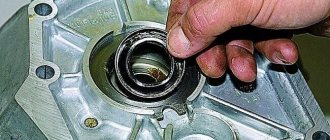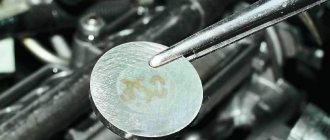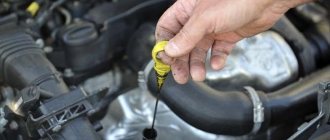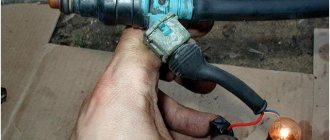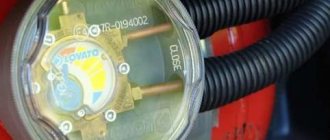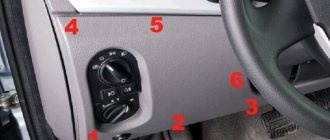A little theory
To understand the reason why gas equipment does not switch to gas, you need to understand the operating principle of this fourth-generation gas equipment unit.
One of the main elements of the system is the electronic control unit, which reads readings from sensors and determines the further actions of the entire system. Gas equipment switches to gas when the temperature set in the ECU is reached. The temperature sensor located on the gearbox measures the temperature of the coolant and transmits the readings to the ECU. After reaching the desired mark, the control unit transmits a signal to the electric valves, one of which is located on the gas cylinder and opens the gas supply, the second makes the gas injectors work and turns off the gasoline supply.
The reason that the HBO does not switch to gas may lie in any of the above system elements.
Spontaneous switching from gas to gasoline and back, reasons:
- First of all, I would recommend starting small - checking and, if necessary, replacing the filter, namely the coarse filter, which is located in the gearbox. If the filter is clogged, the gas supply will be difficult; as a result, the engine will automatically switch to gasoline and continue working on it.
- The problem may lie in the wires of the gearbox temperature sensor. To do this, check the wires for oxidation. Due to oxidation, resistance occurs that interferes with the correct operation of the sensor. As a result, temperature readings can very often vary between 30° and 80°. The LPG begins to change the injection time based on the temperature of the gearbox, and as a result, jerks begin while driving when running on gas.
- Gas quality. Strange as it may seem, it is precisely because of the quality of gas that spontaneous switching from gas to gasoline and vice versa very often occurs. The fact is that most gas installations operate on a propane-butane mixture, which, depending on the time of year, can be “summer” or “winter”. In the so-called “summer” one, butane predominates, in the winter one – propane, since this gas evaporates well even at low temperatures. As for butane, it is heavier and the process of its evaporation begins already at 0° and even +5°. However, due to the fact that butane is cheaper, gas stations are trying to save money and add more butane to the propane-butane mixture. At sub-zero temperatures, such a mixture evaporates poorly, the pressure in the cylinder decreases or even reaches zero, as a result, the liquid fraction of the gas does not enter the reducer. The engine “understands” this phenomenon in its own way, believing that the gas has run out and switches to gasoline.
A solution to this problem can be installing an adapter on the filling fitting and pumping air or nitrogen into the cylinder
4-5 atmospheres. With this modification, you can easily “overwinter” if you don’t let the tank empty completely.
- The gas-gasoline switch is faulty. Often the cause of a malfunction, when spontaneous switching from gas to gasoline and back occurs, may lie in the switch itself. In this case, it is necessary to check the switch and replace it if it is faulty.
- Provided option. If the engine itself switches from gas to gasoline at certain speeds, this may be provided by the settings of one or another LPG kit. There is an option that is provided in some gas installations, when the engine reaches a certain speed, the ECU gives the command to switch to gasoline to achieve greater engine efficiency and develop greater speed, for example, during acceleration or during overtaking.
- Poor gearbox heating. If there is an arbitrary switch from gas to gasoline, the reason may be poor heating of the gearbox with coolant. In this case, it is necessary to check the antifreeze level, as well as the correct connection of the gearbox heating lines; there may be creases or kinks in the hoses. In addition, you should check the vacuum line for air leaks or frozen hoses.
Check the gas reducer itself. Start the engine and let it idle, wait until the transition from gasoline to gas occurs. Then turn off the engine and disconnect the vacuum hose from the gearbox, take a soap solution and soap the outlet for the vacuum hose on the gearbox. The appearance of bubbles on a switched off engine will indicate a gearbox malfunction or the need to install a gearbox repair kit, as described here and here.
Why does the LPG valve get clogged?
For those who do not believe that impurities can be mixed into propane and butane mixture, we want to show a clear example:
When these resins come into contact with a hot valve, it sticks to it. And while the car is standing, this condensate cokes, thereby blocking the opening.
Do-it-yourself treatment of the problem
1) It is necessary to turn off the gas
2) Remove the solenoid valve
3) Clean in gasoline
4) Screw the valve back
5) Open the cylinder
6) Start the car and check the transition to gas.
Do-it-yourself cleaning of the HBO valve at home
The valve must be cleaned with either gasoline or carburetor cleaner.
Valve core overhang before cleaning:
Valve core protrusion after cleaning
Using the Lovato gas reducer as an example, there is a video instruction on how to independently remove, disassemble and wash the gas supply valve core.
Based on your interests, we recommend that you read – Iridium spark plugs for gas selection by car
Especially for Gbo-Time.com readers
Why should problems be fixed immediately?
Gas equipment for injection and carburetor cars, even the best brands, wears out after some time. There are high risks of errors during installation and settings, which ultimately lead to malfunction of the 4th generation gas equipment. Errors during the installation of Tartarini LPG usually appear within the first week of operation.
Failures occur in propane-butane plants and methane-fired plants. When car owners understand gas system problems, issues are resolved faster and cheaper.
The first “bells” appear when filling with gas, when the solenoid valve closes too early and the indicator incorrectly shows the gas level. The operation of the cooling and heating system may be disrupted, the check light is on, the power drops, and if there is gas in the cylinder, the system itself switches to gasoline. The car owner is faced with worn-out injectors, a malfunction of the pressure sensor, gearbox, or a faulty map sensor. Ignoring the “Check Engine” signal leads to burnout of the valve seats.
When converting a car to Euro 4 gas, alpha gas equipment malfunctions largely depend on the professionalism of the technician. Therefore, it is recommended to contact only trusted car services.
Some HBO malfunctions can be repaired with your own hands. If the causes of the malfunction of the 4th generation gas equipment are eliminated initially, the costs are “penny”; in the future they will amount to tens of thousands of rubles.
On a note! It should be remembered that servicing 4th generation gas equipment with your own hands comes down to preventive measures, for example, checking the appearance and tightness of gas lines. A visit to a car service center will not replace this.
Connection diagram of the 2nd generation HBO button to the injector
Installing and connecting the 2nd generation HBO button with your own hands on a car with an injector sometimes causes difficulty.
In fact, everything is much simpler than it seems. The factory instructions for installing the switch indicate the following pinout:
- the white wire should go to the level sensor on the multivalve (if such an indicator is installed);
- yellow goes to the positive of the gasoline valve (if there is emulation of gasoline injectors, this wire is not connected);
- blue connects to the positive terminals of the gas valves of the reducer and the additional remote valve with filter. The injector emulator also cuts into this circuit;
- red goes to the positive terminal of the ignition coil (necessarily with a fuse);
- black - mass;
- brown to the negative terminal of the coil.
It’s hard to disagree with the first three points. But for the rest we will make recommendations:
- The red wire is best connected to the positive side of the ignition switch. Because the coils may have voltage surges. In order not to disassemble the panel, the contact can be found on the fuse block.
- The black wire should only be attached to the car body, like all negative equipment cables.
- Brown, must be wound onto the central high voltage wire of the coil.
It is advisable to do 10-15 turns, without using electrical tape. The electrical tape dries out over time and falls off; it is better to make a knot similar to tying a fish hook.
What to do if HBO does not switch to gas
In most cases, it is possible to detect and repair a breakdown with your own hands.
Airlock
So, the first thing you need to do is bring the level of antifreeze/antifreeze in the expansion tank to normal. Then, by pressing on the radiator pipes and simultaneously releasing gas, try to “drive” the air plug out of the evaporator reducer. If this method does not help, and you are also sure that there is air, then you need to remove the output hose from the gearbox and drain a small part of the liquid (by starting the internal combustion engine for a couple of seconds), after first replacing it with a clean container.
You can detect the presence of a plug in the following way: heat the car engine to operating temperature, compare the heating intensity of the pipes and the evaporator itself.
Next, check the correct installation of the gas equipment (we wrote about this here), also inspect the mechanical damage to the installation, and the presence of kinks in tubes/hoses.
Temperature sensor
If the work done does not give a positive result, you need to make sure that the wires going to the gearbox temperature sensor are intact, and also make sure that its connectors are free of traces of oxidation. Wiring twists are not allowed here, only soldering or secure terminals.
If there is no visible damage to the evaporator temperature indicator, its diagnosis is required. You can find a defect, knowing the parameters (resistance) of a particular sensor, using a multimeter. And if you have a cable for adjusting/diagnostics of gas equipment, as well as software, it will be possible to identify the fault much faster.
The reason that the HBO does not switch to gas (4th generation) is usually a breakdown of the sensor or adjustment of its operating parameters. If adjusting the values does not produce results, it will need to be replaced or repaired.
As an option, to start the gas installation, you can try to short-circuit the sensor wires and then get to the place where it is purchased/repaired.
Problems with the 2nd generation of HBO
In a situation where the 2nd generation of LPG on an injector or carburetor does not switch to gas, there are usually three reasons:
- airing of the gearbox or low fluid level;
- malfunction of the fuel type switch button;
- failure of the gas solenoid valve coil.
You can find all other causes and methods for eliminating them by following the links in the article. If you still have questions, ask them in the form below, we will definitely give a detailed answer.
Is the thermostat at fault?
One of the reasons that the engine cannot switch to gas for a long time is a poorly heated gearbox. Why does this situation arise? One of the most likely causes is a defective thermostat. If it jams, even during a cold start, coolant circulates through the radiator. Accordingly, the engine, antifreeze and radiator warm up slowly. Quite often, the thermostat does not fail immediately, and for some time it would seem to be in working condition, so the owner does not notice the increase in engine warm-up time at the wrong time. Especially in the winter season. This problem is automatically attributed to problems with HBO.
Causes
Let's highlight a few of the most common reasons.
Air lock in the cooling system.
The most common and common reason is that after changing the coolant, air remains in the system and gets into the gearbox. Consequently, the coolant does not circulate and does not warm up the temperature sensor, which is located in the gearbox. The ECU does not receive a signal that the desired temperature has been reached and the car does not switch to gas, continuing to run on gasoline. This can be determined simply by touching the outlet pipe with your hand. Its temperature should be the same as that entering the gearbox.
Solution: Remove the outlet pipe of the cooling system on the gearbox, wait until the air comes out and coolant starts flowing out of the gearbox, put the pipe back in place.
Coolant
If the coolant level is insufficient, the gearbox will not warm up to the required temperature and will not signal the ECU that it is ready to switch to gas. The second point may be at severe subzero temperatures, when the coolant freezes in the gearbox; in this case, the entire cooling system and cabin heater most likely will not work, which can lead to engine overheating.
Solution: check the coolant level and top up if necessary. If the antifreeze freezes, let the engine run for 2-5 minutes, then take a break in operation for the same amount of time until the coolant freezes.
temperature sensor
The second most common reason is a malfunction of the temperature sensor located on the gearbox or a break in the wires leading to it. The sensor does not provide information about the temperature of the gearbox to the electronic control unit and the machine does not switch to gas. It is not difficult to check the functionality of the sensor; you need to take a tester and “ring” the sensor for the presence of resistance. If resistance is present, the sensor can be considered conditionally serviceable. When the engine warms up, the resistance value on the working sensor should change.
Solution: replacing the temperature sensor
Solenoid valve
Failure of the solenoid valve is quite a rare occurrence; a broken wire or oxidation of the valve contacts is much more common. In this case, the ECU sends a signal to the valve to start operating on gas, but either (due to oxidation of the wires) the signal is not received, or (due to a malfunction of the valve) switching to gas does not occur.
Solution: first of all, check the condition of the contacts and remove oxidation, check the integrity of the wires. If the problem persists, replace the valve with a previously working one.
Fuse
The fuse on the main plus of the LPG system has failed or is badly oxidized. In this case, the gas/petrol switch button will also not work.
Solution: Replace the fuse
Symptoms and costs
During the operation of a car with HBO, 18 characteristic malfunctions most often occur.
Some of them are malfunctions in the operation of the gas installation itself, and the other part are typical problems that should be expected from a car powered by gas for a long time. 1. Loss of coolant.
Signs: The coolant level in the reservoir drops below normal. Topping up doesn't help. The situation repeats itself again and again. Puddles (drops) may appear under the car.
Reason: when installing HBO, you have to cut into the cooling system. Coolant is used to warm up the gearbox. Leaks most often appear in “tie-in” areas. The gearbox itself may leak. It is possible for both coolant to enter the intake manifold and gas to enter the cooling system.
Repair cost: 1000-6000 rubles.
2. Engine overheating.
Signs: the temperature gauge needle enters the red zone, the antifreeze is boiling.
Reason: during installation, the circulation of liquid in the system was disrupted, the system became airy.
Repair cost: up to 1000 rubles. It is necessary to remove air from the system, and in some cases replace pipes and clamps.
3. The car jerks when running on gas.
Signs: when running on gas, power increases unevenly, the car jerks, the engine has difficulty maintaining idle speed. At the same time, the engine works perfectly on gasoline.
Reason: It might just be running out of gas. In the case of mechanical gas equipment (I and II generations), the gearbox is probably malfunctioning, or there are leaks in the intake system. In addition, the stepper motor for controlling gas dosing could fail. Injectors (if multipoint injection is available) can also be the culprit.
Repair cost: it all depends on the cause of the problem. A set of LPG injectors including replacement will cost 4,000-9,000 rubles.
4. The gas reserve indicator does not work.
Symptoms: regardless of the amount of gas filled, the indicator shows a value different from the actual one.
Reason: The gas level sensor works on a principle similar to the float in the toilet tank. A stuck float is the most common cause of incorrect readings. Perhaps the reason lies in an electrical fault: no contact, short circuit, etc. and so on.
Cost of repair: most often you can get away with tapping the gas cylinder. If the float comes to life, consider yourself lucky. If not, you will have to prepare from 800 to 2000 rubles.
5. The heating does not work.
Symptoms: Regardless of the position of the set temperature control knob, cold or barely warm air blows from the vents.
Cause: The cooling system became airy during installation. It is possible that the cause of the anomaly is the incorrect installation of the LPG reducer.
Repair cost: removing air from the system will cost no more than 1000 rubles. To change the location of the gearbox you will have to spend up to 3,000 rubles.
6. The gas cylinder cannot be filled completely.
Signs: The gun fires too early.
Reason: Sometimes the gun itself is to blame. However, much more often the cause lies in a faulty filling device valve. It can be replaced or removed and cleaned. Before going to the service center, you should try to fill up with gas at another station, just in case.
Repair cost: a new valve costs from 600 to 1000 rubles. The cost of replacement work is about 500 rubles. But most often you can get away with cleaning the valve - from 500 to 1000 rubles.
7. Power loss.
Signs: in this case we are talking about a situation in which the dynamic performance of the car worsens from month to month, although initially everything was in order. On gasoline the engine runs properly.
Reason: HBO filters may be the culprit, but not only. In old-type mechanical systems (I and II generations), the reason may lie in wear of the gearbox, and in the presence of a multipoint injection system, in malfunctions in the operation of the LPG control electronics or faulty injectors.
Repair cost: replacing the filter will cost 500-1000 rubles. In other cases, costs depend on the specific case.
8. Smell of gas.
Signs: You can smell gas in or near the car.
Reason: The gas has a pungent odor, so even a small amount is immediately noticeable. The cause may be either small leaks or a leaky exhaust system. In old-type systems, due to loss of tightness of the intake duct, gas can enter the air intake system for the passenger compartment.
Cost of repairs: everything is assessed individually in each specific case. The repair begins with a classic check of the tightness of the connections, which will cost approximately 500 rubles. In some situations, the cost of elimination can reach up to 3,000 rubles.
9. The engine does not develop speed.
Signs: The engine runs perfectly at low speeds, but is reluctant to increase speed.
Reason: the reasons can be different, ranging from the prosaic clogging of the gas filter and a faulty gearbox (or its too low performance), and ending with problems with the software.
Repair cost: to replace the filter you will need from 500 to 1000 rubles. To replace the gearbox you will have to pay 10 times more. Diagnostics and tuning are assessed individually, depending on the type of installation and engine.
10. The engine suddenly stalls.
Signs: the engine stalls at the most unexpected moment: at an intersection, when releasing the gas, when braking, etc.
Cause: In older type systems, the cause lies in incorrect adjustment or improper modification of the intake system. Sometimes it turns out that the gearbox is installed incorrectly. In systems with multipoint injection, such problems are not observed, and if something similar happens, then the cause must be sought in the electronic control system.
Cost of repair: repair involves painstaking diagnosis and precise adjustment. Costs will range from 800 to 2000 rubles.
11. The Check Engine light comes on.
Symptoms: The check engine light stays on all the time or only comes on under certain repeating conditions and goes off after a few days.
Reason: for some reason, the composition of the mixture does not correspond to the parameters provided by the car manufacturer. You can drive the car, but ignoring the problem risks burning out the valve seats or damaging the catalyst.
Cost of repair: for diagnostics you will have to pay from 800 to 2000 rubles. Further costs depend on the scope of work.
12. The engine “shoots”.
Symptoms: applies to vehicles with mechanical type LPG for distributed injection. When starting or accelerating from low speeds, the mixture explodes in the intake manifold.
Reason: failure of the ignition system, incorrect adjustment of the mixture composition, installation errors, very large volume of the intake manifold.
Repair cost: replacement of high-voltage wires and spark plugs, and sometimes filters, will be required. For everything you will have to pay about 5,000 rubles. Additional costs will be required for re-adjustment and repair of damage caused by the explosion. The final cost may exceed 15,000 rubles.
13. Worn fuel pump.
Signs: a characteristic hum is heard in the rear of the car. When driving on gasoline, sometimes there is not enough power, the engine runs intermittently and is difficult to start.
Reason: In some cars with LPG, the fuel pump wears out faster than usual. Much depends on the type of equipment and how it is installed.
Repair cost: depends on the model and type of pump. The cost of a new pump is from 2500 to 8000 rubles.
14. Worn valve seats.
Signs: The engine loses power or runs rough. The valve clearance cannot be adjusted correctly.
Reason: wear of valve seats is accelerated not by the gas itself, but by a lean mixture - the result of incorrect adjustment of the gas equipment. It is worth noting that the composition of the mixture must be correct not only in steady-state conditions, but also in transient conditions, for example, during acceleration.
Repair cost: the repair is very serious and consists of dismantling the head and regenerating it. The cost of restoration ranges from 13,000 to 25,000 rubles.
15. Wear of the ignition system.
Signs: an engine with an old type LPG does not work correctly - it “shoots” and stalls. For HBO with multipoint injection, this problem is not typical, or at least has less acute symptoms.
Reason: Creating a spark in a mixture of propane, butane and air requires a higher voltage than in a mixture of air and gasoline. For this reason, the ignition system is more stressed and wears out faster.
Repair cost: for a new spark plug you will have to pay from 150 to 1000 rubles. The cost of new high-voltage wires is from 2,000 to 20,000 rubles. A regular old-style ignition coil will cost about 1,000 rubles, and a cassette – 10,000 rubles.
16. Body corrosion.
Signs: corrosion occurs wherever the LPG installer intervened: near the remote filling device, under the screws securing the LPG wiring to the body, under the screws holding the gearbox, and also in the trunk - in the area where the gas tank is attached.
Reason: installation requires drilling holes in the body necessary for fastening the LPG elements. The holes are protected by simple methods - usually treated with aerosols, which do not always perform their role well.
Cost of repair: sometimes it is enough to clean the damaged areas of rust and re-treat them. In extreme cases, it is necessary to move the attachment points to other places.
17. Exhaust system corrosion.
Signs: the engine is noisy, you smell gas, and the exhaust system resonates when changing speed.
Reason: The combustion of liquefied gas produces more water vapor than the combustion of gasoline. As a result, the exhaust system corrodes faster and mainly on the inside. The exhaust system may "ring" and resonate, although upon inspection it appears to be in good working order and sealed.
Repair cost: in the case of popular cars, replacement will be cheaper: from 5,000 to 10,000 rubles.
18. Damage to the intake manifold.
Signs: the engine runs unevenly, stalls, and does not idle.
Reason: after installing the HBO, depressurization of the manifold may occur at the places where the injectors are installed. In cars with LPG for distributed injection, the gas destroys the manifold and other elements of the intake system, for example, the flow meter.
Cost of repair: It is very rarely possible to restore the manifold or other elements of the intake system. Repair consists of replacing damaged elements with serviceable ones (new or used). It is necessary to prepare for expenses in the amount of 3,000 to 20,000 rubles.
What other problems can there be on a car with HBO?
If the fuse on the main plus of the LPG system has burned out or oxidized, the fuel switch button will not work. Replacing the fuse will resolve the issue.
Malfunctions in the operation of the engine where landi renzo equipment is installed may not necessarily be associated with gas equipment. It is necessary to analyze at what point a situation arises when the internal combustion engine does not switch to gas.
When the speed is floating, the internal combustion engine does not operate smoothly; you need to look for the root cause in the following:
- You need to check the ignition, unscrew it and see what condition the spark plugs are in.
- Be sure to check the compression of the internal combustion engine on the bench.
- Contact a mechanic and have the valves balanced.
- Pay attention to the performance of the lambda probe.
- Adjust gas injection, check injectors.
- There may be malfunctions in the timing of the motor.
Sometimes drivers notice that a gas engine loses its power characteristics. The following breakdowns must be excluded:
- gas injectors do not cope with their task and are poorly adjusted;
- the reducer does not create the necessary pressure due to poor heating;
- the fault is a non-working lambda probe;
- gas filters are clogged;
- blockages in gas lines.
HBO is installed to save fuel. If excessive gas consumption occurs, you need to look for the cause of possible problems:
- broken gearbox, low pressure;
- clogged air filter;
- problems with the ignition system;
- The gearbox does not want to warm up.
- the operation of the gas injectors or injection system is disrupted;
- compression in the internal combustion engine is below normal;
- calibration fittings for injectors are selected incorrectly;
- factory defect of the lambda probe.
If there are failures during re-gassing, you need to re-calibrate the injectors, change the filter, see what pressure is in the reducer and check the integrity of the gas lines.
Spontaneous switching from gas to gasoline and back, reasons:
- First of all, I would recommend starting small - checking and, if necessary, replacing the filter, namely the coarse filter, which is located in the gearbox. If the filter is clogged, the gas supply will be difficult; as a result, the engine will automatically switch to gasoline and continue working on it.
- The problem may lie in the wires of the gearbox temperature sensor. To do this, check the wires for oxidation. Due to oxidation, resistance occurs that interferes with the correct operation of the sensor. As a result, temperature readings can very often vary between 30° and 80°. The LPG begins to change the injection time based on the temperature of the gearbox, and as a result, jerks begin while driving when running on gas.
- Gas quality. Strange as it may seem, it is precisely because of the quality of gas that spontaneous switching from gas to gasoline and vice versa very often occurs. The fact is that most gas installations operate on a propane-butane mixture, which, depending on the time of year, can be “summer” or “winter”. In the so-called “summer”, butane predominates, in the winter – propane, since this gas evaporates well even at low temperatures. As for butane, it is heavier and the process of its evaporation begins already at 0° and even +5°. However, due to the fact that butane is cheaper, gas stations are trying to save money and add more butane to the propane-butane mixture. At sub-zero temperatures, such a mixture evaporates poorly, the pressure in the cylinder decreases or even reaches zero, as a result, the liquid fraction of the gas does not enter the reducer. The engine “understands” this phenomenon in its own way, believing that the gas has run out and switches to gasoline.
A solution to this problem can be installing an adapter on the filling fitting and pumping ~4-5 atmospheres of air or nitrogen into the cylinder. With this modification, you can easily “overwinter” if you don’t let the tank empty completely.
- The gas-gasoline switch is faulty. Often the cause of a malfunction, when spontaneous switching from gas to gasoline and back occurs, may lie in the switch itself. In this case, it is necessary to check the switch and replace it if it is faulty.
- Provided option. If the engine itself switches from gas to gasoline at certain speeds, this may be provided by the settings of one or another LPG kit. There is an option that is provided in some gas installations, when the engine reaches a certain speed, the ECU gives the command to switch to gasoline to achieve greater engine efficiency and develop greater speed, for example, during acceleration or during overtaking.
- Poor gearbox heating. If there is an arbitrary switch from gas to gasoline, the reason may be poor heating of the gearbox with coolant. In this case, it is necessary to check the antifreeze level, as well as the correct connection of the gearbox heating lines; there may be creases or kinks in the hoses. In addition, you should check the vacuum line for air leaks or frozen hoses.
Check the gas reducer itself. Start the engine and let it idle, wait until the transition from gasoline to gas occurs. Then turn off the engine and disconnect the vacuum hose from the gearbox, take a soap solution and soap the outlet for the vacuum hose on the gearbox. The appearance of bubbles on a switched off engine will indicate a gearbox malfunction or the need to install a gearbox repair kit, as described here and here.
Here are all the thoughts on this matter, perhaps the list will seem incomplete to you, and you want to add to it, in which case, do not hesitate and share your thoughts on this issue. If you know other reasons for spontaneous switching from gas to gasoline and back, please share them with us, we will be very grateful. That's all for now, see you again at HBO. Bye.
Operating principle and differences between buttons
The 1-2 generation button on the carburetor has two working positions and one neutral.
- I – the engine starts and runs only on gasoline (gas valve is closed, the red light is on).
- II – The internal combustion engine switches to gas, while the gasoline electric valve closes and the green lamp lights up.
- 0 (Neutral) – serves to burn gasoline from the carburetor float chamber.
Changing the fuel type should only occur through the neutral position. If you turn on the gas right away, two types of fuel will enter the combustion chambers and the engine will most likely stall.
Some copies have an indication of the fuel level in the cylinder, as well as an additional button for the pre-start supply of a portion of gas, which is needed to enrich the mixture when starting a warm engine on gas (for example, Lovato, Logo buttons for a vacuum reducer).
A key such as, for example, Stag 2-G already has a pre-start function built into it, with the ability to adjust by time.
In the injection version, instead of the middle position, there is an automatic mode (on some types, such as Stag 2-W, it can be extreme). In this position, the engine starts on gasoline, and when a certain engine speed is reached, the gas supply is automatically turned on.
Installation of HBO
Gas engine and gas diesel.
14.03.2017
Technologically, there are two options for converting diesel cars to run on gaseous fuel. The first method is to depower the engine and convert it from diesel to gas. The advantage of this method is excellent economic performance and maximum environmental effect.
Converted cars with the ADIS system to a gas engine showed that the car's consumption, compared to a diesel engine, remained at the same level and amounted to 25 cubic meters of LNG instead of 25 l/dt. Accordingly, environmental indicators were optimal, harmful emissions into the atmosphere decreased by up to 90%. But the disadvantage of this method is that a gas engine cannot run on diesel fuel, and you can return the engine to diesel mode if you incur some costs, usually comparable to the cost of a major engine overhaul.
And the second, more common and simpler method is gas-diesel, in which case no changes are made to the engine design. The engine is equipped with gas equipment and a system for limiting the supply of diesel fuel, up to 25% - 35% of the nominal. At the same time, harmful emissions into the atmosphere such as soot, hydrocarbons, CO, benzopyrene, nitrogen oxides, etc. are reduced to 90%.
In this case, we have a slightly smaller economic benefit, replacing not 100% of diesel fuel with gas, but approximately 70%, but it is much easier to convert a car in this way, without making any changes to the design, leaving the diesel mode and adding another engine operating mode - GAS DIESEL , which turns on without stopping the engine by simply pressing a button on the car’s dashboard.
In this case, we have excellent economic efficiency combined with unique emissions! The ignition dose (30% of the nominal amount) of diesel fuel supplied to the cylinder always burns out completely, forming a minimal amount of soot and other harmful substances, compared to the diesel engine operating mode. About the system The “Gazodisel” system is a universal system designed for converting diesel engines to run on all types of gas fuel: CNG (compressed natural gas), LPG (liquefied petroleum gas), biogas, compressed natural gas, hydrogen. The advantage of this system over all analogues on the market is:
- controlled gas supply with phased injection (separately into each cylinder).
- The calculation of injection time and ignition angle (for gas engines) is set according to the algorithm you have specified and is controlled by the ECU.
- the most effective gas supply control algorithm controlled by a computer with protection against all possible errors: all system components are controlled by the ECU with instantaneous interruption of gas supply in case of errors, which makes the operation of the ADIS system as safe as possible
- the ability to update the firmware of the ADIS control unit without replacing it, in the event of developing new software.
- the ability to individually configure this system for the temperature conditions of each region, terrain and transportation characteristics.
The system we use meets the standards of the 4th generation of HBO. It differs from its analogues in the gas-diesel systems market (which operate at the level of the second generation of gas-diesel systems), by separate injection and electronic control of the operation of the entire system, including control of the operation of the diesel fuel supply limitation system, with multi-level protection of the engine and system from failures and critical factors inherent to previous generations.
One of the most important advantages of using gas fuel is the economic feasibility of using gas fuel, most clearly expressed by a reduction in transportation costs by 2-4 times (for example, there are countries where the ratio of the price of natural gas to diesel fuel is one to five). In most countries, the average price ratio of diesel fuel to gas is one to two.
Below is an example for a truck with a consumption of 40 l/100 km. mileage When converting it to a gas engine, instead of 40 liters of d.t. it will consume up to 40 m3 of compressed natural gas, or up to 44 liters of liquefied petroleum gas in the case of a propane-butane mixture.
If we convert the same car to gas-diesel, we will get:
instead of a consumption of 40 liters. D.T. —> 12 l. D.T. + 28 m3 CNG (compressed natural gas) or 20 l. D.T. + 20 l. LPG (liquefied petroleum gas).
Diesel car running on compressed gas - methane
Installation of gas cylinders for methane on a BELAZ mining dump truck
Is it due to circulation?
Another possible reason could be poor circulation of coolant through the gearbox. A problem arises because the channel inside is clogged with sediment. Accordingly, the operation of the entire cooling system is disrupted. Therefore, at first glance, the problem of underheating of the gearbox is the main one, and the owner identifies the cause of the problem as LPG.
We suggest viewing an expert’s opinion on solving this problem:
Of course, the problem may also be a malfunction of the gas system. The gearbox temperature sensor may be faulty, the system may be incorrectly adjusted, the equipment may be handicraft and of poor quality, etc. However, all these problems can only be determined by a specialist.
Filters
Clogged coarse filter or liquid phase filter. If the car owner has not undergone maintenance for a year or more than 10,000 km. path, then the liquid phase filter is most likely clogged and requires replacement.
You may be interested in an article on how to replace filters with your own hands on 4th generation LPG.
Solution: Replace the coarse and fine filters.
Useful tips
When the engine starts to run poorly when switched to LPG, or the gas equipment does not turn on, there is no need to tempt fate and bring the car to a state where it will no longer start at all. It is better to drive on gasoline until the problem is fixed.
The internal combustion engine will not switch to gas automatically if at least one of the sensors (temperature, pressure) is faulty or the gearbox is not heated. If there is no impulse from the tachometer, automatic switching to gas is not possible.
It is highly undesirable to repair gas equipment yourself. To do this, you need to understand the system and have the appropriate diagnostic equipment. First of all, you need to contact the specialists who installed the gas equipment to fix the problem.
When gas-cylinder equipment turns off at the most inopportune moment, it is often the fault of the drivers themselves, who do not want to understand the operation of the system and do not perform regular preventive inspections at the service station.
Breakdowns can occur in cars running on methane or propane-butane. Not all LPG manufacturers take into account that the car will not always be filled with fuel that meets European quality standards. Installing the system in a certified center will minimize the likelihood of problems with gas equipment and engine operation in general.
Types of buttons
Each set of gas equipment is equipped with a button, regardless of the generation of gas equipment or the manufacturer. However, during operation, some components, including the gas-gasoline button, may fail; as a result, the question arises of how to select a new button for the existing set of gas equipment, taking into account the characteristics of a particular engine. You should also take into account the fact that there are many types of switches and if you choose the wrong option, certain difficulties may arise.
So, when choosing, you should consider:
- Type and generation of gas equipment. For HBO 2, the switch from HBO 4 and vice versa will not work;
- Type of fuel system. For a carburetor system, the gas-gasoline button for the injector is not suitable. These switches have a completely different type of electronic control and the switching itself occurs differently;
- The type of the HBO button itself. In addition to the type of fuel and generation of gas equipment, you must choose between the types of the button itself. They can be different, from the simplest to the very complex. The latter can be equipped with various indicators, as well as external displays, which display data on the gas balance, as well as the operating mode of the gas-gasoline system. Data comes from various sensors that monitor the operation of the gas equipment. Installing an HBO button of this type is much more difficult, as it requires in-depth knowledge in the field of electronics.
